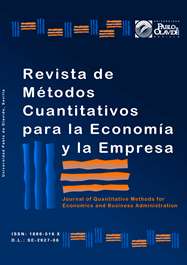// Application of Six Sigma DMAIC with Discrete Simulation and Multicriterial Techniques
DOI:
https://doi.org/10.46661/revmetodoscuanteconempresa.2337Keywords:
Seis Sigma, simulación discreta, lenguaje Arena, índice PRES, Six Sigma, discrete simulation, Arena language, PRES indexAbstract
In this paper we show the results achieved by integrating Six Sigma, discrete simulation techniques and multi-criteria techniques for improving a beauty service that desires to obtain the best compromise solution between incomes, costs, use of resources and customer satisfaction. DMAIC methodology was used to propose a procedure that defines, for each phase, simulation tools, multi-attribute decision making, statistics and quality control and management. The use of simulation allowed us to analyze the different actions for improvements and determine the values of the variables of interest being defined by the administrative group. We used, between multi-criteria techniques, PRES index for ranking the actions according to experts' preferences.
Downloads
References
Aragonés B.P. (2010): Técnicas de ayuda a la toma de decisiones en proyectos. Apuntes. Departamento de Proyecto, Universidad Politécnica de Valencia.
Bertels, T., y Patterson, G. (2003): Selecting Six Sigma Projects That Matter. Six Sigma Forum Magazine, Vol. 3, No. 1, pp. 13-15.
Chacón, E. y García, M. (2007): Selección de proyectos de Seis Sigma mediante el uso de AHP y ANP, Proceeding 12 Internacional Conference on Project Engineering, Zaragoza, España.
Garza, R., González, C., Pérez, I., Martínez, E. y Sanler, M. (2012): Concepción de un procedimiento utilizando herramientas cuantitativas para mejorar el desempeño empresarial. Revista Ingeniería Industrial, Vol. XXXIII, No. 3, pp. 239-248.
González, C., Garza, R., y Malo, E. (2014): Enfoque híbrido simulación-proceso analítico jerárquico. Caso de estudio rediseño de un restaurante. Revista Métodos Cuantitativos para la economía, Vol 17, pp 23-41.
Grima, P., Almagro, Ll. M., Santiago, S. y Tort-Martorell, X. (2014): Six Sigma: hints from practice to overcome difficulties. Total Quality Management & Business Excellence, Volume 25, Issue 3-4, pp 198-208.
Guasch A., Pera M.A., Casanovas J. y Figueras J.(2003): Modelado y simulación. Aplicación a procesos logísticos de fabricación y servicios. 2da Edición, Editorial Ediciones de Universidad Politécnica de Cataluña, pp. 187-201.
Gutiérrez, H. y de la Vara, R. (2008): Control estadístico de calidad y Seis Sigma, 2da edición. Editorial McGraw Hill, México.
Kelton, W.D., Sadowski, R. y Sturrock, D. (2009): Simulation with ARENA, 3ra edición, Editorial Mc Graw Hill Science Engineering.
Kendrick, J. y Saaty, D. (2007): Use of Analytic Hierarchy Process for Project Selection. Six Sigma Forum Magazine, Vol 6, No.4, pp 22-29.
Law A. (2006): Simulation Modeling & Analysis with expertfit software. 4ta Edición, Editorial Mc Graw Hill International.
Law, A. M. (2009): How to build valid and credible simulation models. Proceeding of the 2009 Winter Simulation Conference, pp 24 -33.
McCarty, T, Bremer, M. y Daniels, L. (2005): Six Sigma black belt handbook. Editorial McGraw Hill.
Ocampo, J. y Pavón, A. (2012): Integrando la metodología DMAIC de Seis Sigma con la Simulación de Eventos Discretos en Flexsim. Proceeding of the 10 Latin American and Caribbean Conference for Engineering and Technology, paper No 147, Ciudad de Panamá, Panamá.
Porter, E.M. (2002): Ventaja competitiva. Creación y sostenimiento de un desempeño superior. Editorial Patria, México.
Ríos, I.D., Ríos, I.S. (2008): Simulación. Métodos y aplicaciones. Editorial RA-MA, 2ª edición España.
Tolamatl, J., Gallardo, D., Varela, J.A. y Flores, E. (2011): Aplicación de Seis Sigma en una microempresa del ramo automotriz. Revista Conciencia Tecnológica No. 42, pp 11-18.
Downloads
Published
How to Cite
Issue
Section
License
Copyright (c) 2016 Journal of Quantitative Methods for Economics and Business Administration

This work is licensed under a Creative Commons Attribution-ShareAlike 4.0 International License.
Submission of manuscripts implies that the work described has not been published before (except in the form of an abstract or as part of thesis), that it is not under consideration for publication elsewhere and that, in case of acceptance, the authors agree to automatic transfer of the copyright to the Journal for its publication and dissemination. Authors retain the authors' right to use and share the article according to a personal or instutional use or scholarly sharing purposes; in addition, they retain patent, trademark and other intellectual property rights (including research data).
All the articles are published in the Journal under the Creative Commons license CC-BY-SA (Attribution-ShareAlike). It is allowed a commercial use of the work (always including the author attribution) and other derivative works, which must be released under the same license as the original work.
Up to Volume 21, this Journal has been licensing the articles under the Creative Commons license CC-BY-SA 3.0 ES. Starting from Volume 22, the Creative Commons license CC-BY-SA 4.0 is used.










